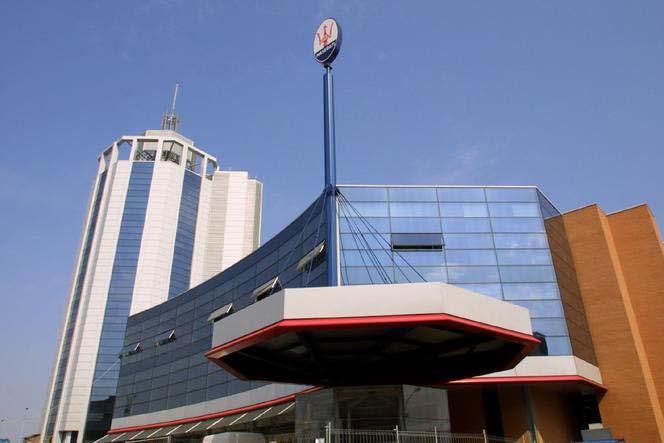
8 minute read
The Maserati Company Today
Maseratitoday is a modern and fast growing specialist car manufacturer with representations worldwide. In 2005 the Maserati ownership has been transferred from Ferrari S.p.A. to Fiat PartecipazioniS.p.A.
In 2007, the growing trend of the last years has been confirmed,with constantly improving economic results and a total number of 7496 sold vehicles, with respect to 5734 units in 2006. The Quattroportehas reconfirmed itself as the best selling car of the Maserati model range with more than 5000 sold cars in 2007, and has scored 40 national and international awards since its 2003 launch.
An important part of the company’s resources has been spent for the development of new models, with the launch of the QuattroporteAutomatic at the Detroit motor show in January, the new GranTurismomodel at the Geneva motor show in March and the QuattroporteSport GT S at the Paris motor show in October, all in 2007.
An important event for Maserati in 2007 was the start of production of the complete new GranTurismomodel, which replaces the outgoing Coupé/GranSport. Designed by Pininfarinain the tradition of the great Maserati grand touring cars of the 1950’s and 1960’s, the car scored an instant commercial success and is world-wide renowned for its stunning design.
For a better commercial focalise on its most important markets, Maserati has now subsidiaries in the United States, the United Kingdom, France, Germany and Switzerland, and a new sales structure being established for the fast growingChinese market.
Also in the sporty sphere, 2007 was a highly successful year forthe MC12 racing cars with the winning of the manufacturer’s world championship title, the consolidation of both team’s and driver’s world championship titles for the third consecutive year and the winning of the Citation Cup, all in GT racing.
IntroductiontoMaserati
Maserati facts and figures:
President: Sergio MARCHIONE
Chief Executive Officer: Roberto RONCHI
Alfredo ALTAVILLA
IntroductiontoMaserati Maserati Road Cars
Maserati Road Cars
1500 Gran Turismo(A6)
Years of production: 1946-1950
Numbers produced: 61 Engine: 6 cylinder, 1500cc, 65 hp
It was already in 1941 that the decision was made for the development of a GT car, but the first examples of Maserati’sfirst ever road car were not built until 1946. However this car was officially called “1500 Gran Turismo”, it is better known under its project name A6 (Alfieri, 6-cylinder). The over head cam engine had a sophisticated valve command system and the tubular chassis was innovating for its time with round section steel tubes. Except for one experimental prototype built by Zagato, all bodies were built by Pinin Farina. First examples had covered head lights and a different rear section. The car received its final body style in 1948 (see picture).

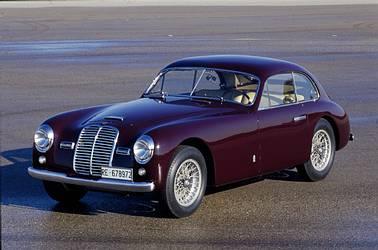
2000 Gran Turismo(A6G)
Years of production: 1950-1951
Numbers produced: 16 Engine: 6 cylinder, 2000cc, 100 hp
The A6G or 2000 Gran Turismohad a new two-litre engine based on the power unit of the A6GCS racing cars. Compression ratio and thus power was reduced to allow the engine to run on commercial fuel, of which excellent quality was not always guaranteed. Coupé bodies ware built by Frua, Vignaleand PininFarina and an elegant spyderversion was created by Frua. All bodies were of great luxury, refined and cured in every detail. However a high list price and performances not matching the quickly changing standard in the luxury car segment didn’t favour its sales. Only 16 pieces were produced.
A6GCS BerlinettaPininFarina
Years of production: 1953-1954
Numbers produced: 4 Engine: 6 cylinder, 2000cc, 170 hp
A very special car was presented at the Turin motor show of 1954. It concerned a 2000 Sport fitted with an elegant closed “berlinetta”body from PininFarina. The 2000 Sport (project name A6GCS) was a higlysuccessful open 2-seater race car designed for road races and was much beloved by the racing drivers of the area forits excellent driving qualities. An elegant berlinettabody from PininFarina on this basis was the right recipe for one of the most beautiful creations in automotive history. Only four of them were built (chassis 2056, 2057, 2059 and 2060), but chassis 2060 had a short life as it was re-bodied as an open race car in 1955 and received a new identification number (2086). This car is one of the most sought-after historic Maseratis. One of them is on display at the Paninicollection.

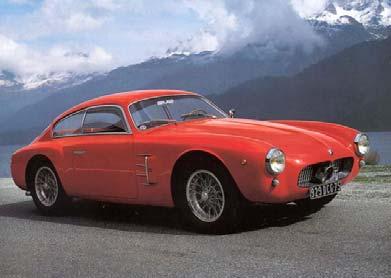
2000 Gran Turismo(A6G54)
Years of production: 1954-1957
Numbers produced: 60
Engine: 6 cylinder, 2000cc, 150 hp
The experience gained with the successful 2000 Sport was used for a small series GT cars with elevated performances and reserved to a limited numberof elite customers. The A6G54 twin cam engine of the 2000 Sport was detuned and had now a classic oil sump instead of a dry sump lubrication system. Its 150 horse power gave the 2000 Gran Turismoof 1954 the true GT performance its predecessor lacked and thiscar was highly appreciated by the public. Coupéand spyderbodies were made by Frua, Zagatoand Allemano.
IntroductiontoMaserati Maserati Road Cars
3500 GT & GTI
Years of production: 1957-1964
Numbers produced: 1983 (all versions)
Engine: 6 cylinder, 3.5L, 220 & 235 hp
The 3500 GT was an important car for Maseratias it was the first production car to be built in large numbers. In 1957 Maseratihad officially withdrawn from motor racing and full attention was now on the production of Gran Turismoroad cars. The elegantly shaped body of the 3500 GT was a creation from CarrozzeriaTouring and was made from aluminium which was attached to a tubular steel frame (Superleggerapatent). The 6cylinder engine came from the 350S racing car of 1956 and was characterised by excellent torque values at low engine speed. In 1961, the triple Weber carburettors were replaced by a mechanical fuel injection system from Lucas, boosting the power to 235 hp. Injection equipped vehicles were referred to as 3500 GTI. This car became a big commercial success and contributed importantly in resolving the economical difficulties of Maseratiat the time.
3500 GT & GTI Spyder
Years of production: 1958-1964
Numbers produced: 242
Engine: 6 cylinder, 3.5L, 220 & 235 hp
Almost simultaneously with the coupé, an open version of the 3500 GT was under development. Early prototypes of the Spyderwere made by Touring and Frua, but the final design was a masterpiece of designer Giovanni Michelotti when he was working for Vignale. The body was now made from steel instead of aluminium and was fitted on a 10 cm shortened chassis. Also the Spyderadopted the Lucas fuel injection system and its drum brakes were replaced by more modern disc brakes on later versions, although drum brakes remained available upon request.
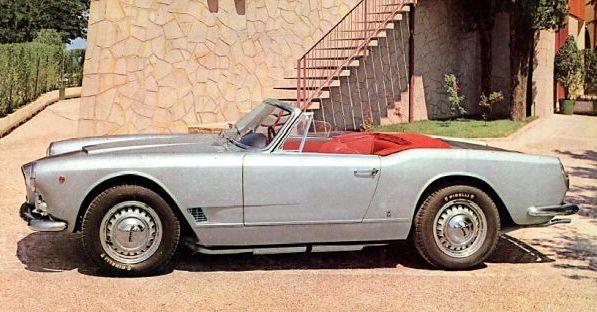

IntroductiontoMaserati Maserati Road Cars
5000 GT Sebring
Years of production: 1959-1966
Numbers produced: 34 Engine: 90°V8, 5.0L, 325 & 340 hp
The worldwide success of the 3500 GT has drawn much attention tothe Maseratibrand. Some however desired from Maseratia Gran Turismothat was even more exclusive. On specific request of the Shah of Persia the 5000 GT was born. Chief engineer GiulioAlfieri used only the very best components available to built this extraordinary car. Its powerful V8 engine originated from the 450S racing car by which Juan Manuel Fangioand Jean Behrawon the 1957 Sebring 12 hours race and the vehicle used a reinforced 3500 GT chassis. The brake system was servo-assisted with discs on the front wheels and drums on the rear. Performances were unprecedented for a road car at the time. Bodies for the 5000 GT were created by the worlds most famous coachbuilders: Touring, PininFarina, Monterosa, Allemano, Ghia, Bertone, Vignaleand Frua.
Years of production: 1962-1968
Numbers produced: 600 Engine: 6 cylinder; 3.5L, 3,7L & 4.0L; 220-265 hp
Before the sales of the 3500 GT began to slow, Maseratipresented its new Sebring coupe at the Geneva motorshowof 1962. The new car was named after the race track in Florida were the 450S racing cars obtained an important win a few years earlier. The Sebring was based on the short 3500 GT Spyderchassis and its 2+2 body was a design from Michelotti during his time at Vignale. The 6-cylinder engine had always fuel injection from Lucas and total displacements were 3.5L, 3.7L and also 4.0L from 1965, with power outputs varying from 220 to 265 hp. The Sebring showed a number of technical improvements over the 3500 GT. Automatic transmission, air conditioning and Borraniwire wheels were available on request.
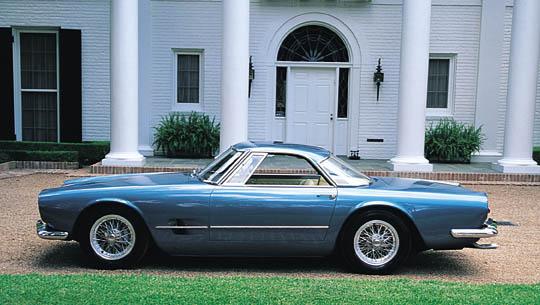
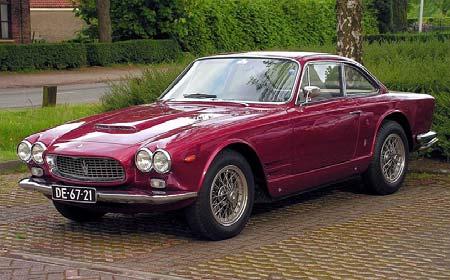
IntroductiontoMaserati Maserati Road Cars
Quattroportel
Years of production: 1963-1969

Numbers produced: 776
Engine: 90°V8, 4.1L & 4.7L, 260 & 290 hp
In the early 1960’s, GiulioAlfieri started to work on a completely new project. Inspired by the success of its Gran Turismocars, Maseratiwas now thinking about a saloon car. The new Quattroporte(Italian for “four doors”) must of course have the same level of elegancy, refinement, power and performances as the other trident products. With a top speed of 230 km/h, it was the fastest saloon production car at the time. The design was from Pietro Fruaand the car had a modern sheet metal monocoquestructure instead of a tubular frame. The De Dion rear axle was replaced by a more traditional rigid axle and the option was offered for a more powerful 4.7 engine when a second series was presented in 1966. A curious detail: 5 Quattroporteswere converted into pick-ups by coachbuilder Graziaof Bologna and were used as fire extinguisher cars on the Italian race tracks.
Mistral & Mistral Spyder
Years of production: 1964-1969
Numbers produced: 955
Engine: 6 cylinder; 3.5L, 3,7L & 4.0L; 220-265 hp
With this car started Maserati’stradition to name its Gran Turismocars after famous winds (the Ghibli, Bora, Merak, Khamsin, Karifand Shamalwould follow). The Mistral shared its mechanical base with the Sebring but, thanks to its 2-seater fastback body from Pietro Frua, had a much more modern appearance compared to the more traditional styled 2+2 Sebring. A first prototype of the Mistral was presented at the Turin motorshowin the autumn of 1963 but production didn’t start before 1964. The body was from steel but the doors, bonnet and rear window frame were made from aluminium to reduce the weight. An open Spyderversion was presented at the Geneva motorshowin March 1964. The Spyderwas produced in about 120 units.


IntroductiontoMaserati Maserati Road Cars
Mexico
Years of production: 1966-1972
Numbers produced: 485
Engine: 90°V8, 4.1L & 4.7L, 290 & 300 hp
After the 5000 GT and the Quattroporte, the Mexico is Maserati’sthird road car using a civilised version of the V8 race engine from the 450S sport prototype race car. A first prototype of the Mexico was shown in 1965, but the official presentation of the final version was at the Paris motorshowin 1966. The sober but balanced and elegant design from Vignalekeeps the middle between a 4-seater coupe and a 2-door saloon car and the car offers comfortable interior space to four people thanks to its 2640 mm wheelbase. The Mexico shares its mechanical base with the Quattroporteand has a steel monocoque structure combined with a front auxiliary frame. The Mexico was available with both 4.1L and 4.7L engine and has a top speed between 250 and 260 km/h.

Ghibli& GhibliSpyder
Years of production: 1967-1972
Numbers produced: 1280
Engine: 90°V8, 4.7L & 4.9L, 340 & 330 hp
In 1966 a project was started for a new sporty Gran Turismoin the best tradition of the MaseratiBrand. The new Ghibli, named after a desert breeze, was strictly a 2-seater and its beautiful design was a true masterpiece of the young designer GiorgettoGiugiaro during his period at Ghia. The body of the Ghibliwas perfect in every detail and is still regarded as one of Giugiaro’smost beautiful designs. The V8 engine from the Quattroporte/Mexico adopted a dry sump lubrication system in order to fit under the long and low Ghiblibonnet. From 1969 the Ghibliwas also made available with a 4.9L engine, named GhibliSS, and an open Spyderversion was added, of which only 125 units were produced.











